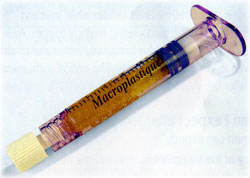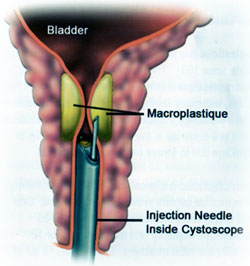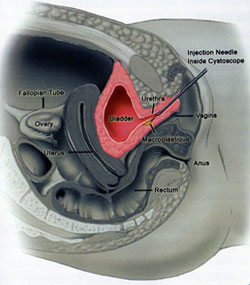If you worry about occasional bladder leakage, a condition called urinary incontinence, you are not alone. Millions of women worry about bladder leakage — a frustrating and often embarrassing condition that can affect a women’s lifestyle, relationships, and emotional well-being.
Approximately 13 million people in the United States are affected by stress urinary incontinence (SUI). Of the 13 million, 85% are women. While SUI occurs more frequently in older women, SUI affects women of all ages and is not necessarily a result of getting older. More importantly, incontinence is treatable and is usually curable. You don’t have to live with the effects of incontinence.
What is Macroplastique? |
|
Macroplastique is an injectable soft-tissue urethral bulking agent for treating stress urinary incontinence primarily due to intrinsic sphincter deficiency. Macroplastique is made up of two parts – the water soluble gel (polyvinyl) that is absorbed and removed from the body in urine and the man-made, rubber-like, silicone elastomer implant material (cross-linked polydimethylsiloxane) that is permanent and not absorbed by the body. It is this permanent material that causes the bulking effect around the urethra after implantation. |
Is Macroplastique right for me? |
 |
|
Your doctor will perform tests to determine what type of incontinence you have and the cause for your incontinence. You and your doctor will then decide on the treatment that is most suitable for you. Macroplastique may be right for you, even if other incontinence treatments such as a surgical sling procedure has failed. |
How does Macroplastique work? |
|
Macroplastique is injected into the tissues surrounding the urethra. The increased “bulk” allows the urethra to close more effectively and prevents urine from leaking. |
How is the Macroplastique treatment performed? |
 |
|
The procedure to inject Macroplastique can be performed in your doctor’s office or in a outpatient clinic or hospital in approximately 30 minutes. Prior to the procedure, the doctor will give you an antibiotic to reduce the rick of injection. Upon the start of the procedure, the doctor will give you an antibiotic to reduce the risk of infection. Upon the start of the procedure, the doctor will give you local anesthetic in the tissues near your bladder to reduce discomfort. A small optical instrument (cystoscope), placed in the urethra, is used during the procedure to allow your doctor to view your urethra and bladder while injecting Macroplastique into the surrounding urethral tissue. Your doctor will also fill your bladder to halfway with water or saline to better view the implantation area. The optical instrument is removed after the injection and your treatment is complete. |
What can I expect after the procedure? |
 |
|
Most women can expect: *To stay at the treatment facility until the numbness from the anesthetic is gone and they can urinate on their own. If you have difficulty urinating after the procedure, a catheter may be inserted until you urinate normally. * To receive a prescription for antibiotics to prevent infection. It is important to take this antibiotic to reduce the risk of a urinary tract infection. * To resume their normal daily activity and return to work within a few days. Your doctor will provide you with more specific instructions about your own recovery and if any restrictions on normal activities are recommended. |
Are there times when Macroplastique should not be used? |
|
You cannot be treated with Macroplastique if you have an infection or inflammation of the kidney, bladder or urinary tract, or vagina. Your doctor will test your urine to ensure you do not have a urinary tract infection because the Macroplastique injection cannot be performed until an infection has been treated. Also, Macroplastique cannot be injected if the tissue around your urethra does not look healthy to the doctor. This treatment has not been evaluated in pregnant women or women who had a child within the past year. |
What are the treatment benefits? |
|
The benefit of Macroplastique treatment is that you could be free from unwanted urinary leakage (dry) or have fewer episodes of urinary leakage. Other commercially available bulking agents may be absorbed into the body; Macroplastique is made of a water-soluble gel that is removed from the body leaving behind the permanent silicone elastomer implants. |
What are the risks I should know about? |
|
As with any treatment, there are risks involved . It is important to discuss risks and side effects with your doctor before undergoing any type of medical treatment. Risks following a Macroplastique treatment include pain related to the procedure (which can be controlled with pain medication), small amount of blood in your urine, having to use the bathroom more often or more urgently, delayed voiding, painful urination, and/or urinary tract infection. There is also a potential risk related to receiving anesthesia during treatment. If after 48 hours you have urination that is difficult, frequent, or painful, or there is blood in your urine, contact your doctor immediately. These may be signs of other more serious problems. An additional risk is that you may experience no benefit from Macroplastique treatment. This could happen if Macroplastique is placed too deeply in the tissue, thereby creating poor bulking around the urethra. Also, if you have a different type of incontinence (i.e., urge incontinence) or your incontinence condition worsens (i.e., due to urethral hyper mobility), Macroplastique may not be an effective treatment for you. |
Will I need more than one treatment? |
|
In the clinical trial, about half of the patients requested an additional treatment to either further improve or cure their incontinence. Uroplasty recommends patients wait 12 weeks between treatments to allow healing and accurately see the full effect of the first treatment. Talk to your doctor about and additional treatment if you continue to experience urine leakage. |
What are long-term results? |
|
The long-term results with Macroplastique have not been established. Eighty-four women participated in the Macroplastique clinical trial for 2 years. Using the same physician’s scoring system reported at 12 months (Stamey Grade), 63 out of these 84 women were improved at 2 years. However, too many women did not attend their 2-year exam to assess improvement at 2 years. Therefore, the actual improvement rate beyond 12 months is unknown. If you symptoms do not improve or if symptoms return after treatment with Macroplastique, there are other options available. |